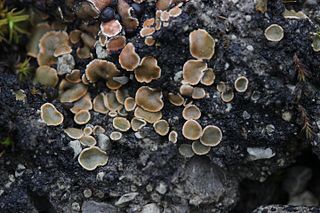
Psora is a genus of lichen-forming fungi in the family Psoraceae. Members of the genus are commonly called fishscale lichens. Lichens in the genus Psora generally have a squamulose thallus and anthraquinones in the hymenium. Photobiont partners of Psora lichens include members of the green algal genera Asterochloris, Chloroidium, Myrmecia, and Trebouxia.

The Lecideaceae are a family of lichen-forming fungi in the order Lecideales. It contains about 30 genera and roughly 250 species. A major distinguishing characteristic of the family is the lecanoroid form of the fruiting bodies: typically circular, dark, and without a thalline margin. Most species in the family are lichenised with green algae, although a few species, scattered amongst several genera, are lichenicolous—they live on other lichens. Lecideaceae lichens tend to grow on rocks, wood, and soil. Several Lecideaceae species accelerate the weathering of rock surfaces, a process known as pedogenesis, by extending their hyphae into cracks and expelling rock flakes. This contributes to significantly faster weathering rates in certain environments, impacts various materials from natural rocks to man-made Sekishu roof tiles, and involves key biomolecules identified for survival and biodeterioration, including compounds to withstand intense ultraviolet radiation.

Immersaria is a genus of lichen-forming fungi in the family Lecideaceae. It has eight species of crustose lichens.

The Tephromelataceae are a family of lichenized fungi in the order Lecanorales. The family was circumscribed by Austrian lichenologist Josef Hafellner in 1984. Tephromelataceae comprises the genera Tephromela, Calvitimela, Mycoblastus and Violella, which together constitute a well-supported monophyletic group.
Bibbya is a genus of fruticose lichens in the family Ramalinaceae.

The Rhizocarpales are an order of lichen-forming fungi in the subclass Lecanoromycetidae of the class Lecanoromycetes. It has two families, Rhizocarpaceae and Sporastatiaceae, which contain mostly crustose lichens.

Carbonicola is a small genus of lichen-forming fungi. It is the sole genus in the monogeneric family Carbonicolaceae. The genus, which collectively has an almost cosmopolitan distribution, contains three squamulose lichens that prefer to grow on burned wood in temperate areas of the world.

Lecidea tessellata is a species of saxicolous (rock-dwelling), crustose lichen in the family Lecideaceae. It was formally described as a species in 1819 by German botanist Heinrich Flörke. In northern North America, it is common and widely distributed, growing on non-calcareous rocks. It also occurs in Afghanistan, China, Nepal, Europe, and Russian Asia. In India, it has been recorded only from the alpine Western Himalayas at an altitude of 3,450 m (11,320 ft). Its southern distribution extends to James Ross Island, where it is locally common.
Lecanactis minutissima is a species of corticolous (bark-dwelling), crustose lichen in the family Roccellaceae. Found in Sri Lanka, the lichen is characterised by its pale ochraceous thallus and sessile apothecia with dark brown discs, covered with thick white granular pruina.
Cratiria sorediata is a species of corticolous (bark-dwelling), crustose lichen in the family Caliciaceae. It was first described as a new species in 2009. The type specimen was collected from Aldabra in the Seychelles.
Lecidea lygommella is a species of saxicolous (rock-dwelling), crustose lichen in the family Lecideaceae. It spreads up to 7 cm wide with a thin thallus varying in colour from whitish and pale grey to rusty red-brown, featuring areolate surfaces with irregularly shaped areoles. Its fruiting bodies range from slightly embedded to sitting atop the thallus and black, flat to slightly convex apothecial discs. Unlike its lookalike Lecidea lygomma, L. lygommella does not produce any secondary chemicals. It is found in New South Wales and Victoria, Australia, where it grows on rocks in alpine areas.
Placolecis kunmingensis is a species of saxicolous (rock-dwelling), crustose lichen in the family Catillariaceae. It is found in Yunnan, China. The lichen is characterised by a thallus that is areolate to squamulose in its centre, forming irregular patches or clumps 10–50 mm wide, as well as its ellipsoid or spherical ascospores with slightly thickened wall.
Tetramelas flindersianus is a saxicolous (rock-dwelling) crustose lichen species in the family Physciaceae. First described scientifically in 2020, it is found in Australia.
Buellia cravenii is a species of saxicolous (rock-dwelling), crustose lichen in the family Caliciaceae. It is found in Australia. The lichen spreads up to 3.5 cm wide thick, forming a continuous, grey-white cracked pattern of areoles.
Byssoloma xanthonicum is a species of corticolous (bark-dwelling), crustose lichen in the family Pilocarpaceae. It is found in New Caledonia.
Fulgidea is a genus of lichen-forming fungi in the family Umbilicariaceae. It has two species of squamulose lichens that grow on bark and on wood.
Lecidea toensbergii is a species of saxicolous (rock-dwelling), crustose lichen in the family Lecideaceae. Described as a new species in 2018, it has been documented from several locations in Norway and a single location in Sweden, where it grows in rocky alpine environments.

Lecaimmeria is a genus of lichen-forming fungi in the family Lecideaceae. Established in 2022, it comprises 13 species of lichens that grow on rock surfaces (saxicolous) and form a thin, crust-like covering (crustose) on their substrate. These lichens are characterised by their glossy, orange to red-brown outer layer (thallus) and sunken fruiting bodies (apothecia) with red-brown centres. Lecaimmeria species are typically found in harsh environments at high altitudes or latitudes, particularly in mountainous regions of western China and across parts of Eurasia. The genus was created to accommodate species previously classified under Immersaria that shared certain distinct features, following molecular analysis that revealed they formed a separate group.

Romjularia is a fungal genus in the family Lecideaceae, containing the single species Romjularia lurida, a saxicolous and terricolous squamulose lichen.
Boreoplaca is a fungal genus in the family Ophioparmaceae. It comprises the single species Boreoplaca ultrafrigida, a saxicolous (rock-dwelling), squamulose lichen. Both the genus and species were described in 1994 by the Norwegian lichenologist Einar Timdal. The lichen is found in Eastern Siberia, the Russian Far East as well as in adjacent territories of north-east China, and in South Korea. The main characteristics of the lichen are its squamulose thallus, black lecideine apothecia, and Fuscidea-type asci.









